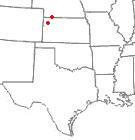|

Colby, Kansas | SamsDad,
Do you have any yield data available, I certainly think that is where I would start, multiple years would be great. I think dloc brings up an interesting point about losses, the answer to that is certainly geographic in nature. Out here on the high plains we don't have the conditions (16-22" of precip over deep silt loams) conducive to losses such as many others face (like 40" over sand). I'm somewhat convinced we could treat our nitrogen in a checkbook method much like phosphorus.
Last year we did some preliminary work at KSU looking at VRT N where one of the inputs was OM as measured by the Veris NIR rig we were looking at. The variability in O.M. is certainly nothing to ignore, but can be minor in comparison to the yield potential component of any N rec at high yield levels. From what I've seen the thing most interesting about spatial OM data, is not its impact on a N-rec but how it may represent the long-term productivity of that area within a field, which is intuitive more yield = more biomass + lots of time = Higher OM.
Several things to keep in mind, although there is a lot of organic material in the soil as noted by soilman, only a small portion of that is located in a fast cycling available pool. In terms of N contribution KSU recs estimate 20 lb per % of O.M. Another concern to keep in mind, as is often discussed in regard to sensor based N management, is the possibility of "mining" your organic matter.
Here is a possible approach (not necessarily right, but what I would do), assuming you have yield data, and assuming that corn is in your rotation often
1. Normalize yield data for each corn crop, creating a surface of some type (NormalizedYield = Yield at this spot / Field Average)
2. Average the normalized data (may consider removing a year that had some huge externalities, like hail, flood, etc.)
3. Determine what your whole field yield goal is, I think most people expect their yield goal to increase gradually each year due to better genetics, management, etc.
4. Multipy your Field Level Yield Goal with your Average Normalized Data, this will be a Yield Potential Layer
5. You could use an OM and Deep NO3 value for the entire field (field composite sample), perform selected "zone" sampling based on soil and previous yield history, or apply a grid sampling strategy.
6. Plug your yield potential layer, OM values, and profile NO3 into the N rec of your choice
7. VRT rec ready for controller
Wow, when I list it out it looks simple, but everybody here knows thats not the case, there are a lot of potential arguments embedded in what I just proposed. Look forward to further talk on this post.
Lucas
| |
|


 Variable rate N
Variable rate N